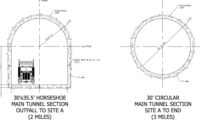Construction Risk Management
Will AIA's Revised Contract Options Prompt More Insurance Coverage?

Builders risk insurance policies pack together different property insurance coverages for construction projects. They also often contain coverage for “civil authority” or “expediting cost” and “ingress/egress” insurance.
That type of coverage is going to be even more widely recognized because of the release in April of a new insurance exhibit by the American Institute of Architects.
Designed to be attached to AIA owner/contractor agreements, the AIA document details a number of optional extended coverages that are currently in use on some projects but not necessarily as widely known as they should be.
Designed to be attached to AIA owner/contractor agreements, the AIA document details a number of optional extended coverages for the first time. Owners of projects worth $10 million and up are more likely to be aware of the coverages, said Kenneth Rubinstein, a Boston-based attorney at PretiFlaherty and an expert on issues related to builders risk insurance. Mark Katz, a New York City-based attorney, says that the coverages are "provided in the vast majority of policies I am seeing, even those issued to owners of mid-sized projects."
Delay and completion coverage remains optional, often provided by endorsement, said Katz, a partner at Mound Cotton Wollan & Greengrass.
AIA standard form agreements, which are updated from time to time but comprehensively revised once per decade, are believed to have the biggest sales in the U.S. The AIA says it obtains input from all segments of the industry when the updates are prepared.
AIA documents, and in particular Article 11 of A201, always addressed property coverage and other insurance requirements. But with the increasing complexity of risks and coverages, AIA "felt that the best way to go with insurance affecting the owner-contractor relationship was to create an exhibit that went into significant detail on insurance and bonds," said Ken Cobleigh, managing director of the American Institute of Architect's Contract Documents program.
Rival standard form agreements, such as ConsensusDocs and those produced by the Engineers’ Joint Contract Documents Committee, have been published for many years, too.
There are important differences. For example, where the AIA insurance exhibit is agnostic on whether an owner or prime contractor should purchase the builders’ risk insurance, ConsensusDocs in its most recent version changed the default from the owner to the constructor because its authors believe constructors can purchase the coverage at less cost.
Brian Perlberg, the Associated General Contractors’ senior counsel for contracts and ConsensusDocs executive director, says he is concerned that the new optional AIA insurance exhibit, with its different coverage options, “will become a requirement that doesn’t match what is readily available int he current insurance market or be prohibitively expensive.” AGC’s review team for the new AIA documents, said Perlberg, thought it would be better for the owner to get some of the additional coverages listed in the AIA exhibit “rather than have the contractor stuck with a requirement that it couldn’t comply with.”
That the AIA’s new insurance exhibit gives higher profile to several types of coverage is without question. They include loss of use, business interruption, delay in completion, ordinance or law, expediting cost, extra expense insurance, civil authority, ingress/egress and soft costs.
Differences with Prior AIA Standard Form Agreement Versions
The prior AIA standard form agreements were silent on ingress and egress and civil authority coverage, as well as soft costs, said Steven Coombs, a principal at LaGrange Park, Ill.-based risk management and commercial insurance consulting firm, Risk Resources, and co-author of a 2010 book on builders risk insurance published by the International Risk Management Institute.
Even so, project owners, to one degree or another, have been adding a number of these optional areas of coverage to their builders’ risk policies, Coombs notes.
Project owners are adding loss of business use and delay of completion coverage about half the time now, with this option especially popular when it comes to large projects for obvious reasons, Coombs said.
“If you have a $200 million hospital project, I would expect it would have loss of use insurance,” he said.
Ordinance and law insurance is also pretty popular, though the potential exposure is not huge. Rather, it covers the cost of upgrades that are required to a project due to building laws and codes that were changed after construction started, Coombs said.
Coombs estimates project owners will pay for expediting clause and extra expense coverage over 50% of the time. The expediting and extra expense coverage enables the project owner and contractor to keep moving ahead with work despite a loss or major disruption, instead of having to remobilize crews and restart work 18 months down the line.
Meanwhile, civil authority and ingress/egress insurance is particularly popular with project owners in areas subject to natural disasters, such as hurricane-prone Florida, Coombs said.
Just take the example of a project owner forced to stop work on a new hotel in the Florida Keys after the state’s governor orders an evacuation ahead of an oncoming hurricane. The storm then wipes out a bridge to the island where the hotel is being built.
Civil authority insurance would cover losses stemming from the government evacuation order, while ingress/egress coverage would deal with the interruption in work causes by the lost bridge, Coombs said.
“Civil authority and ingress/egress is typically used in those geographic areas subject to widespread catastrophes,” he said.
And Coombs sees project owners add soft cost insurance to two out of three builders’ risk policies, with particular interest in coverage for interest payments on construction loans should there be a delay.
The new AIA exhibit, given it spells out the array of optional builders’ risk coverages, could help set expectations in the market as both to what is available and, more pertinently, what is fair, Rubinstein noted.
“This may affect what the norms are,” Rubinstein said. “Everybody wants to feel two things. Nobody wants to get screwed and buy something they don’t want to buy and everybody thinks they are being fair. Over time, having an AIA standard insurance exhibit may affect the balance of what the owner asks for and what the contractor is willing to provide.”





